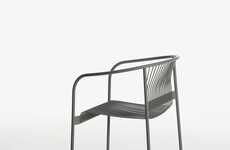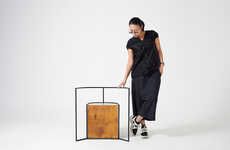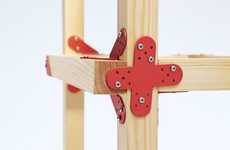
The Linon Chair Embodies Clean-Cut Lines and a Firm Metal Frame
Amelia Roblin — October 22, 2013 — Art & Design
References: albertovitelio & mocoloco
I would be very interested in testing out the Linon Chair and Stool by Alberto Vitelio. The pair might come across as being a little on the stiffer side of the comfort scale, but each one seems to have been constructed in such a way that caters to ergonomics. The armchair, for instance, features a nice reclined backrest with a generously angled slope designed for maximum relaxation.
The creator was playing with structure and geometry while composing these two pieces, choosing slender metal bars for a rigid frame and planar panels of plywood to construct the seats. The resultant forms of the Linon Chair and Stool suggest more space than they actually occupy, ultimately paying homage to modern furniture design with a fresh take to intrigue the contemporary taste.
The creator was playing with structure and geometry while composing these two pieces, choosing slender metal bars for a rigid frame and planar panels of plywood to construct the seats. The resultant forms of the Linon Chair and Stool suggest more space than they actually occupy, ultimately paying homage to modern furniture design with a fresh take to intrigue the contemporary taste.
Trend Themes
1. Plywood Furniture - The use of plywood as a construction material is becoming more prevalent in modern furniture design, offering a sustainable and cost-effective alternative to traditional materials.
2. Ergonomic Seating - Designers are increasingly focused on creating furniture that prioritizes comfort and ergonomic support, from office chairs to living room seating.
3. Minimalist Aesthetics - Simple, clean-cut lines and geometric shapes define many contemporary furniture designs, emphasizing a minimalist aesthetic that values function over form.
Industry Implications
1. Furniture Manufacturing - Manufacturers in this industry can explore the use of sustainable materials like plywood to create modern, minimalist furniture designs that prioritize comfort and ergonomic support.
2. Interior Design - Interior designers can utilize the trend of minimalist aesthetic to create sleek and contemporary living spaces that emphasize functionality and comfort.
3. Architecture and Engineering - Professionals in this industry could incorporate ergonomic seating options into building designs, such as office spaces, to promote comfort and productivity among employees.
4.5
Score
Popularity
Activity
Freshness























